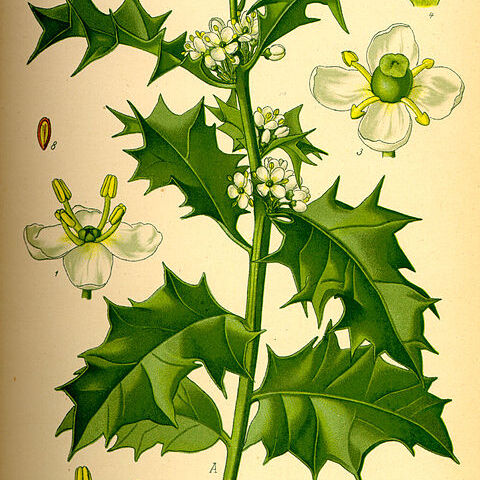Shrubs or trees, usually dioecious. Leaves alternate, opposite or in pseudowhorls, simple; stipules small or absent. Flowers in axillary racemes or panicles of cymes, or in terminal and subterminal racemes, or rarely solitary. Flowers small, actinomorphic, hypogynous, generally unisexual, 4–6 (occasionally 7–8)-merous. Sepals free or cohering at base, imbricate. Petals free or united, imbricate or valvate or absent. Stamens usually as many as and alternate with petals, sometimes epipetalous, or up to 12, reduced to staminodes in female flower; anthers opening by longitudinal slits, introrse. Disc absent. Ovary 2-or 4–8 (rarely to 24)-locular, with 1, rarely 2, pendulous anatropous ovules per locule; style terminal, short; stigma lobed or capitate; ovary rudimentary in male flower. Fruit a drupe with as many pyrenes as carpels, or fewer. Seeds with a small straight embryo; endosperm copious, oily. [This description from the Aquifoliaceae treatment in Volume 22 of the Flora of Australia (Pedley 1984: 199) includes the genus Sphenostemon which is now placed in the family Paracryphiaceae (Australian Plant Census, accessed 10 September 2020), and hence requires revision-editorial note, 10 September 2020.]
Trees or shrubs, mostly evergreen, usually practically glabrous. Leaves alternate or rarely opposite, simple; stipules minute or absent. Flowers regular, hermaphrodite or sexes separate, in cymes or fascicles, rarely solitary. Calyx-lobes 4–6(–9), imbricate. Corolla rotate; petals 4–5(–9), free or joined at the base, imbricate or valvate; disk absent. Male flowers with 4–5(–9) stamens, free or inserted at the base of the corolla-tube, alternating with the petals, hypogynous; anthers dithecous, opening by longitudinal slits; rudimentary ovary 1-locular. Female flowers: ovary superior, (2–)3(–22)-locular; ovules 1–2 in each locule, pendulous; style terminal or absent; stigma capitate or discoid; staminodes present but anthers sessile or on shorter filaments. Fruit a drupe with (1–)2–6(–many) 1(–2)-seeded pyrenes. Seeds with copious endosperm
Ovary superior, 3-or more-locular; style terminal or stigma sessile; ovules 1–2 in each loculus, pendulous from the apex
Stamens hypogynous, 4 or 5, alternate with the petals, rarely more numerous, free; anthers 2-celled, opening lengthwise
Fruit drupaceous, of 3 or more 1-seeded pyrenes; seed with copious fleshy endosperm and small straight embryo
Ovary superior, 3-or more-celled; style terminal or absent; ovules 1–2 in each cell, pendulous from the apex
Flowers actinomorphic, hermaphrodite or unisexual, fasciculate or subumbellate or rarely solitary
Flowers frequently dioecious, actinomorphic, cymose, fasciculate, subumbellate or rarely solitary
Stamens free, alternate with the corolla-lobes; anthers 2-thecous, opening lengthwise
Petals 4 or 5, free or connate at the base, hypogynous, imbricate
Seeds with copious fleshy endosperm and small straight embryo
Leaves alternate, simple; stipules absent, or rarely present
Petals free or connate at the base, imbricate or valvate
Leaves alternate, simple; stipules absent or very small
Trees or shrubs, mostly evergreen
Trees or shrubs, mostly evergreen
Calyx-lobes imbricate
Calyx-lobes imbricate
Fruit drupaceous
Disk absent
Disk absent

